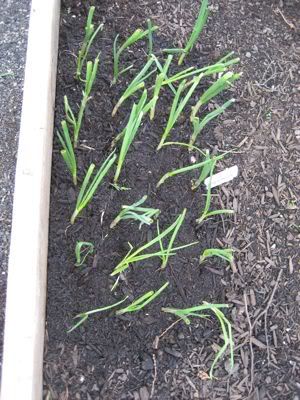110 days. Large, flattened, globe shaped bulbs with light brown skin and mild white flesh. This yellow Spanish-type onion is famous for its sweetness. Best used fresh, as it has a short shelf life.
CULTURE: Onions prefer light, sandy, loamy soils, so the most successful onions are grown in well prepared, well dug, well drained soil with plenty of added organic matter and lots of sunshine. Apply 1/4-1/2 cup of our complete fertilizer per 5 row feet, 1-2 inches below the transplant or seed. Thin bulbing onions to 5 inches between plants and bunching onions to 2 inches between plants. When planting out, take the clump and separate the grass-like seedlings and place in a shallow trench, 4-5 inches apart. Fill the trench around the seedlings and then water. Onion seedlings are tough and will perform amazingly well.
LONG-DAY/SHORT-DAY: Onions are photoperiodic plants. They regulate their stages of growth by the duration of the light/dark cycle at the particular time of the year they are growing. The onion plant will make top growth until the critical light duration is reached, and bulbing begins. The amount of growth and development prior to bulbing will determine the bulb size. Long-day varieties need to be planted as early as possible in the spring to obtain sufficient growth prior to the longest day, when they begin to bulb. Short-day varieties need to be fall planted to obtain enough growth to make a large bulb earlier in the year when the days are shorter. The dividing line between short-day and long-day varieties is generally accepted as 36° latitude, roughly along the Kansas/Oklahoma border. Plant long-day varieties north of this line and short-day varieties south of it. New breeding efforts have developed day-neutral varieties. Day-neutral and intermediate-day onions can be grown successfully anywhere.
INSECT/PESTS: Because of their pungent odor, onions repel many pests and protect other garden vegetables. Onions are a valuable companion plant and should be integrated throughout the garden.
DISEASE: Most onion disease results from improper growing conditions. Practice strict sanitation procedures.
HARVEST: When the tops begin to dry out and are falling over, withhold watering if possible, so the bulbs mature in dry soil. After about half the tops have fallen, push over the remainder, wait about 1 week and harvest the bulbs. Spread the bulbs out in the sun and cover with a sheet or tarp at night to prevent dew from remoistening them. Cure them for a week or so to toughen the skins. Proper curing is essential to promote long storage. If weather is poor at this time, cure on the floor of the garage, barn, or house.
STORAGE: Keep onions in onion sacks so they get good ventilation, and hang sacks where air is dry and cool (55-65°F). Check sacks occasionally, and immediately remove any sprouting or rotting onions."
----------
PURCHASED: Starts from Garden Fever March '09.
STARTED SEED:
HARDENED OFF:
TRANSPLANTED IN GARDEN: 03/30/09
DISEASE ISSUES:
INSECT ISSUES:
HARVEST YEILD & DURATION:
OTHER NOTES:
03/30/09

No comments:
Post a Comment